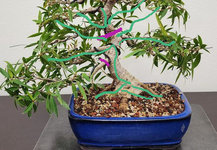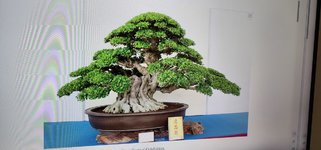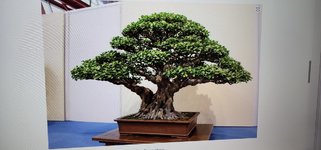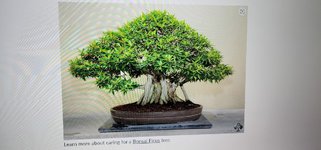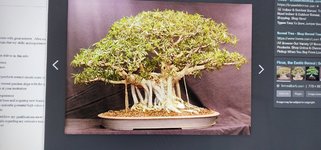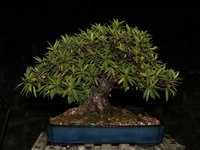I have had this tree for several years, and I am struggling with some creative issues in recent years. The tree is healthy and responds well to any direction I give it, but the biggest problem is when I look at it, it feels... contrived. Too symmetrical, too upright, too linear, too many branches, too novice.
What I want for this tree ultimately is a large outdoor banyan style specimen tree, the kind that will be the focal point of a garden I haven't designed yet. Possibly 4 feet tall or so. I feel it has to undergo some preparatory work to correct its direction so its not delayed on its journey. I need help and ideas to kickstart my imagination.
I feel it has some good points that I like. It has developed a strong base and good-looking nabari. The lower third of the tree has decent taper and ramification, although the bottom-most branch on the left is positioned too fat to the front of the trunk, and bent unnaturally to position the foliage to the left side.
The points I'm not liking are that the current style is remnicent of a Christmas tree, the bends in the trunk are an uninspiring zigzag style, the branches are somehow predictable and cluttered at the same time while varying in thickness fairly little.
Part of my plan for spring is a repot and root trim to slow down the larger surface nebari and promote smaller surface roots to develop and catch up. I want to upsize the pot to promote rapid growth up top, while planting off-center to create some visual appeal. Maybe the pot in the photos or something larger. I was thinking of growing some clippings into whips to approach graft to branches as aerial roots.
The rest of the plan is unwritten, and I need inspiration and ideas on how to correct this trainwreck early and clarify an image to move it forward towards. No input is unappreciated.
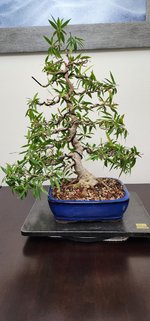
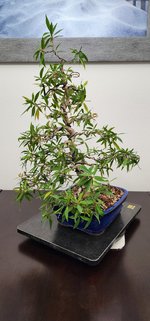
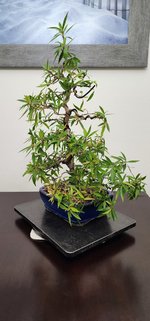
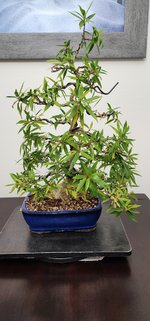
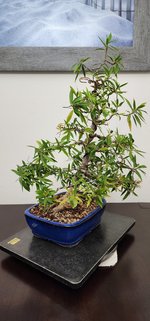

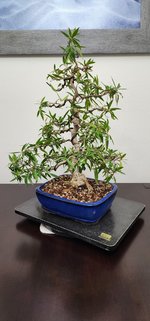
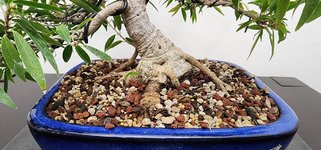

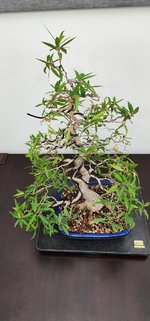
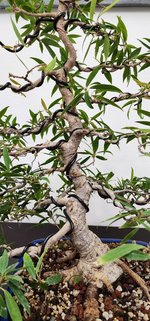
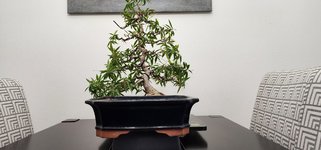
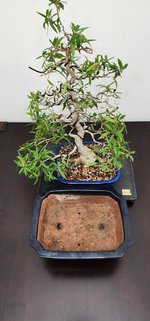
What I want for this tree ultimately is a large outdoor banyan style specimen tree, the kind that will be the focal point of a garden I haven't designed yet. Possibly 4 feet tall or so. I feel it has to undergo some preparatory work to correct its direction so its not delayed on its journey. I need help and ideas to kickstart my imagination.
I feel it has some good points that I like. It has developed a strong base and good-looking nabari. The lower third of the tree has decent taper and ramification, although the bottom-most branch on the left is positioned too fat to the front of the trunk, and bent unnaturally to position the foliage to the left side.
The points I'm not liking are that the current style is remnicent of a Christmas tree, the bends in the trunk are an uninspiring zigzag style, the branches are somehow predictable and cluttered at the same time while varying in thickness fairly little.
Part of my plan for spring is a repot and root trim to slow down the larger surface nebari and promote smaller surface roots to develop and catch up. I want to upsize the pot to promote rapid growth up top, while planting off-center to create some visual appeal. Maybe the pot in the photos or something larger. I was thinking of growing some clippings into whips to approach graft to branches as aerial roots.
The rest of the plan is unwritten, and I need inspiration and ideas on how to correct this trainwreck early and clarify an image to move it forward towards. No input is unappreciated.














